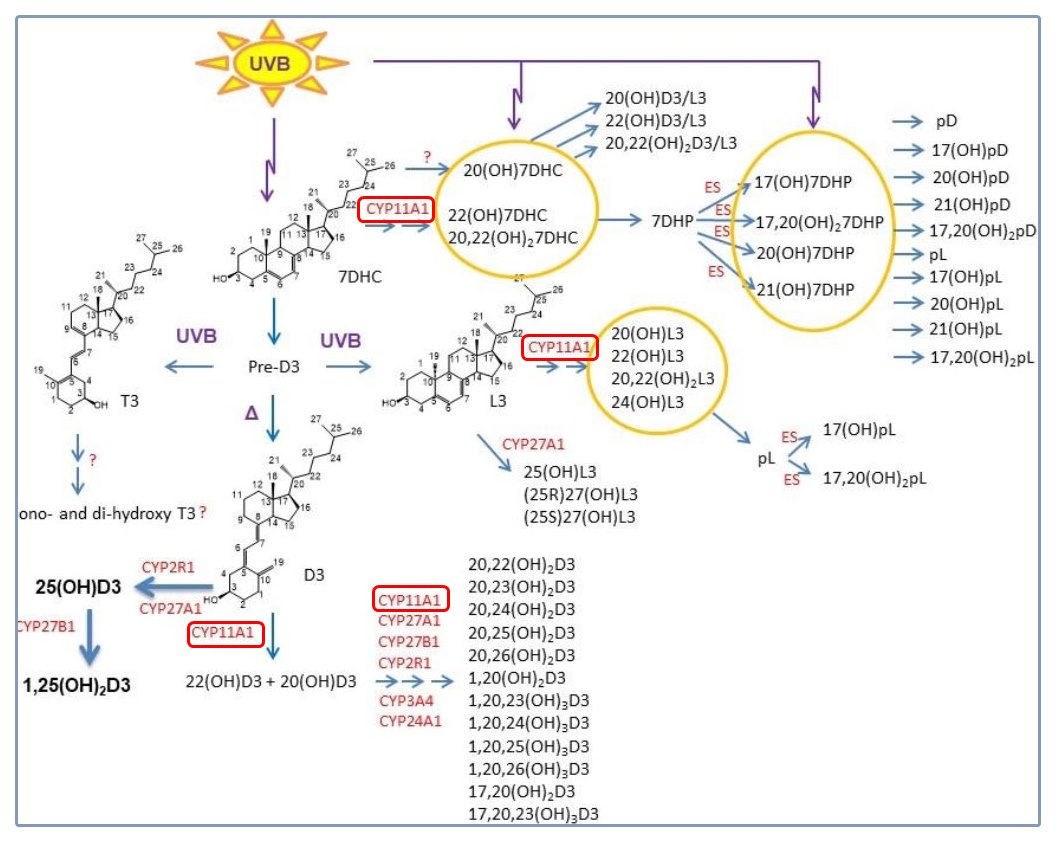Many Vitamin D metabolites: some help skin aging, reduce Cytokine storms, but are not tested
The Impact of Vitamin D on Skin Aging
Review Int J Mol Sci. 2021 Aug 23;22(16):9097. doi: 10.3390/ijms22169097.
Georgeta Bocheva 1, Radomir M Slominski 2 3, Andrzej T Slominski 2 4 5

 Figure 1. Noncanonical pathways of vitamin D3 and lumisterol (L3) activation (reprinted from [61] with the permission from Springer). D3, L3, and 7-DHC are substrates for CYP11A1 that produces the corresponding hydroxyderivatives. In the case of L3 and 7-DHC, the side chain can be cleaved by CYP11A1 to produce 7DHP or pL that can be further metabolized by steroidogenic enzymes (ES). In the skin, UVB acting on 5,7-dienes can lead to the production of D3, L3, and T3 derivatives with a full-length side chain and pD, pL, and pT derivatives with a shortened side chain.
While the cut-off for UVC/UVB is 280 nm, we show the range of 290–315 nm because wavelengths below 290 nm are filtered by the ozone layer and no additional pre-D3 is produced above 315 nm [170]. 7DHC, 7-dehydrocholesterol; 7DHP, 7-dehydropregnenolone; pD, preganacalciferol; pL, preganalumisterol; D3, vitamin D3; L3, lumisterol; T3, tachysterol; OH, hydroxyl group; number before OH, carbon number with OH; number in subscripts after (OH), number of hydroxyl groups.
Two of the authors of this study are also co-authors of:
* COVID-19 cytokine storms perhaps better stopped by the CYP11A1 Vitamin D pathway – Aug 11, 2020
* That references an earlier, simpler Vitamin D metabolism chart
*
Figure 1. Noncanonical pathways of vitamin D3 and lumisterol (L3) activation (reprinted from [61] with the permission from Springer). D3, L3, and 7-DHC are substrates for CYP11A1 that produces the corresponding hydroxyderivatives. In the case of L3 and 7-DHC, the side chain can be cleaved by CYP11A1 to produce 7DHP or pL that can be further metabolized by steroidogenic enzymes (ES). In the skin, UVB acting on 5,7-dienes can lead to the production of D3, L3, and T3 derivatives with a full-length side chain and pD, pL, and pT derivatives with a shortened side chain.
While the cut-off for UVC/UVB is 280 nm, we show the range of 290–315 nm because wavelengths below 290 nm are filtered by the ozone layer and no additional pre-D3 is produced above 315 nm [170]. 7DHC, 7-dehydrocholesterol; 7DHP, 7-dehydropregnenolone; pD, preganacalciferol; pL, preganalumisterol; D3, vitamin D3; L3, lumisterol; T3, tachysterol; OH, hydroxyl group; number before OH, carbon number with OH; number in subscripts after (OH), number of hydroxyl groups.
Two of the authors of this study are also co-authors of:
* COVID-19 cytokine storms perhaps better stopped by the CYP11A1 Vitamin D pathway – Aug 11, 2020
* That references an earlier, simpler Vitamin D metabolism chart
*  CYTOKINE in VitaminDWiki12 titles as of Aug 2021
CYTOKINE in VitaminDWiki12 titles as of Aug 2021
📄 Download the PDF from VitaminDWiki
The active metabolites of vitamin D3 (D3) and lumisterol (L3) exert a variety of antiaging and photoprotective effects on the skin. These are achieved through immunomodulation and include
anti-inflammatory actions,
regulation of keratinocytes proliferation, and
differentiation programs to build the epidermal barrier necessary for maintaining skin homeostasis.
In addition, they
induce antioxidative responses,
inhibit DNA damage and
induce DNA repair mechanisms to attenuate premature skin aging and cancerogenesis.
The mechanism of action would involve interaction with multiple nuclear receptors including VDR, AhR, LXR, reverse agonism on RORα and -γ, and nongenomic actions through 1,25D3-MARRS receptor and interaction with the nongenomic binding site of the VDR. Therefore, active forms of vitamin D3 including its canonical (1,25(OH)2D3) and noncanonical (CYP11A1-intitated) D3 derivatives as well as L3 derivatives are promising agents for the
prevention,
attenuation,
or treatment of premature skin aging.
They could be administrated orally and/or topically.
Other forms of parenteral application of vitamin D3 precursor should be considered to avoid its predominant metabolism to 25(OH)D3 that is not recognized by CYP11A1 enzyme.
The efficacy of topically applied vitamin D3 and L3 derivatives needs further clinical evaluation in future
